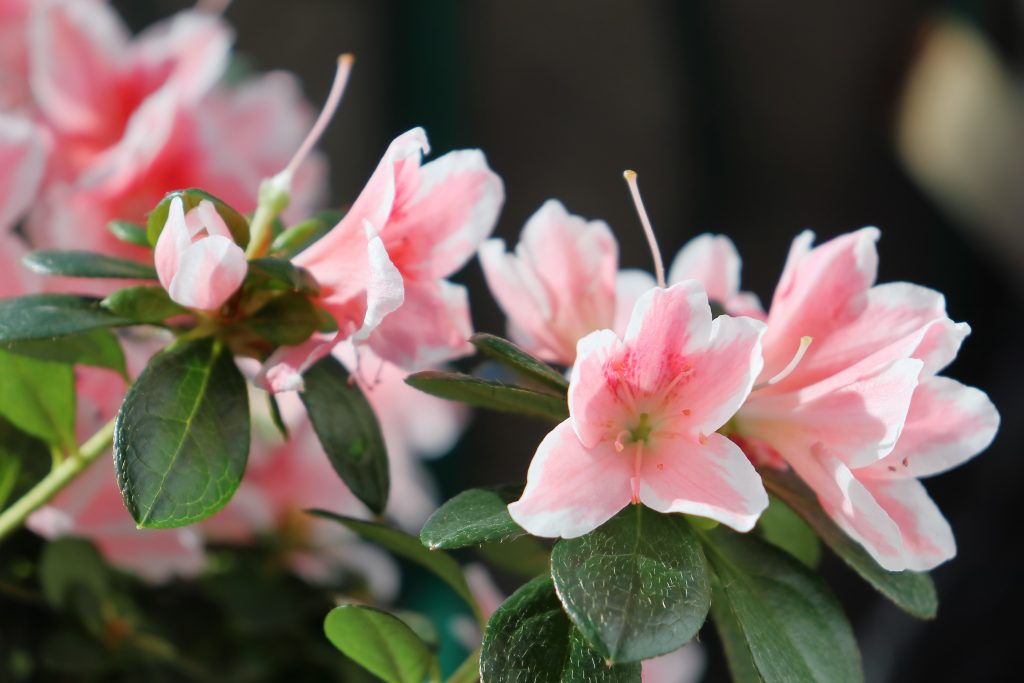All azaleas are technically “rhododendrons” but not all rhododendrons are azaleas; Weston Nurseries’ online Plant Library lists “Azalea” as the common name, with “Rhododendron” as the botanical genus. To readily distinguish between rhododendrons and azaleas in bloom, simply count their stamens. Azalea flowers have five stamens, or one per flower-lobe, while rhododendron flowers have 10 (or more) stamens, or two per lobe. Azaleas also tend to have tubular or funnel-shaped flowers, while rhododendron blooms are generally more bell-shaped. See our “Rhododendron Garden Guidelines” information document for more detailed information.

Azaleas are classified as either evergreen or deciduous. In general, evergreen azaleas have a mounding growth habit while deciduous types tend to grow more upright. When planted in a proper location with rich soil, all azaleas will thrive for decades with minimal care.
Evergreen azaleas, with their explosion of colorful spring blossoms, are a welcome sight when winter releases us from its frosty grip; they typically retain a portion of their foliage over the winter, opening their blooms starting in mid-May in Hopkinton.

Deciduous azalea cultivars can bring appealing scents to your property, as well as season-extending blooms. Many deciduous hybrids and cultivars begin flowering before summer begins, carrying their foliage beauty into the fall, before dropping their leaves for winter. The so-called “summer azaleas” are deciduous azaleas that bloom in Hopkinton from mid-June and through much of July, depending upon the cultivar.
Soil and Moisture
All azaleas prefer acidic soil, high in organic content that drains well and is properly prepared. Since they are shallow rooted, it is easy for them to dry out and, at the same time, drown if over-watered. Sandy or dry soil should be amended before planting as should heavy clay; add peat moss, peat humus or compost to remedy the problem. Some native azaleas and cultivars, including Azalea viscosum, will tolerate damp soil conditions. Mulching will help retain moisture, discourage weeds, and cool the soil.
Sun
Evergreen azaleas prefer partial shade where they are protected from wind and harsh summer and winter sun. Planting them in a protected eastern or northern exposure is preferable to western or southern. However, a southern exposure can work if it is shaded, the soil is rich, and the plant is protected from wind. Many will tolerate deep shade, although they may become leggy and not flower as heavily. Deciduous azaleas prefer full sun but will tolerate light shade. If planted in shade, they will become open branched, flower less profusely, and be less vigorous. Azalea arborescens, Azalea viscosum, and Azalea vaseyi and their cultivars can tolerate more shade than others.
Fertilizing
Azaleas generally need minimal supplemental feeding. A balanced fertilizer for acid-loving plants, such as Holly-Tone can be applied conservatively each spring.
Pruning
Spent flowers can be removed to promote new growth but is rarely necessary. Evergreen azaleas rarely require pruning, but if necessary should be pruned right after flowering. Deciduous azaleas require pruning only if the plants become leggy and should be done right after flowering.
Winter Protection for Evergreen Azaleas
In challenging locations, evergreen azaleas may benefit from winter protection. If the site receives full sun and or the site is windy, an application of an anti-desiccant spray such as Wilt-Pruf can help prevent the plant from drying out. Providing additional water in the fall, if the season is dry, will also help. In our climate, evergreen azaleas are often considered semi-evergreen and may lose a major proportion of their leaves over winter. They may look a bit scruffy in the spring, but will recover quickly. Often, an azalea that has lost most or all of its leaves after a harsh winter will leaf out and perform admirably. In some cases, the plant will flower heavily, but have no foliage until new growth is pushed out. Weston Nurseries has developed and introduced some azaleas for improved performance in Zone 5 gardens, including ‘Bixby’, ‘Pink Clusters’ and ‘Majesty’.
Problems
- Deer enjoy browsing on azalea foliage and buds so depending on where you live, you may need to protect your azaleas from deer damage. Deterrents such as foliar sprays and scent barriers, as well as heavy duty plastic netting can be used to prevent damage.
- Azaleas are bothered by relatively few insects; all can be managed with proper culture and insecticides.
- Black vine weevil larvae live in the soil and feed on azalea roots and stems. They can even girdle the stem of the plant, removing bark and killing the plant. The adult weevil chews notches in the leaves.
- Lacebugs are small and nearly transparent, feeding on the underside of the leaves, causing them to turn grayish.
- Azalea stem borers enter the tips of stems and bore into larger stems, sometimes causing stem dieback.
- Fungal problems can occur on azaleas, but well drained soil and proper maintenance will help prevent them; a fungicide application may be helpful for some situations.
- Phytophthora root rot can become active if the soil stays too damp for extended periods of time. Leaves on an infected plant will curl and brown and appear dry. The plant is not dry, however, but affected by extremes of soil moisture. Improving drainage is the best way to prevent this fungus.
- Leaf spot fungus appears as brown circles on the leaves; wet weather and overhead watering enhance its likelihood. Watering with a soaker hose instead of sprinklers will help hold this fungus at bay.
- Powdery mildew can attack evergreen azaleas if conditions are right—when the air is damp or when the plant is shaded—and appears as a white coating on the leaves.







